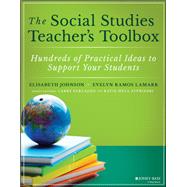Social studies teachers will find classroom-tested lessons and strategies that can be easily implemented in the classroom
The Teacher’s Toolbox series is an innovative, research-based resource providing teachers with instructional strategies for students of all levels and abilities. Each book in the collection focuses on a specific content area. Clear, concise guidance enables teachers to quickly integrate low-prep, high-value lessons and strategies in their middle school and high school classrooms. Every strategy follows a practical, how-to format established by the series editors.
The Social Studies Teacher's Toolbox contains hundreds of student-friendly classroom lessons and teaching strategies. Clear and concise chapters, fully aligned to Common Core Social Studies standards and National Council for the Social Studies standards, cover the underlying research, technology based options, practical classroom use, and modification of each high-value lesson and strategy.
This book employs a hands-on approach to help educators quickly learn and apply proven methods and techniques in their social studies courses. Topics range from reading and writing in social studies and tools for analysis, to conducting formative and summative assessments, differentiating instruction, motivating students, incorporating social and emotional learning and culturally responsive teaching. Easy-to-read content shows how and why social studies should be taught and how to make connections across history, geography, political science, and beyond. Designed to reduce instructor preparation time and increase relevance, student engagement, and comprehension, this book:
- Explains the usefulness, application, and potential drawbacks of each instructional strategy
- Provides fresh activities applicable to all classrooms
- Helps social studies teachers work with ELLs, advanced students, and students with learning differences
- Offers real-world guidance for addressing current events while covering standards and working with textbooks
The Social Studies Teacher's Toolbox is an invaluable source of real-world lessons, strategies, and techniques for general education teachers and social studies specialists, as well as resource specialists/special education teachers, elementary and secondary educators, and teacher educators.









